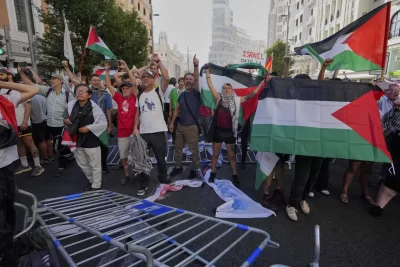
JERUSALEM — Israel’s Cabinet voted Monday to seize the Gaza Strip for an unspecified amount of time in a move that could see Israel reestablish control over a territory it vacated two decades ago.
Israel withdrew from Gaza in 2005 after a decades-long occupation and then imposed a blockade on the territory along with Egypt.
Israeli officials did not clarify Monday what a reoccupation of Gaza would entail, but the announcement raises the potential for the reestablishment of Israeli settlements inside the territory. Israel’s settler movement has been emboldened under its current ultranationalist government.
Details were not formally announced, and Israeli leaders have said the expansion of operations will not begin until after President Donald Trump’s visit. The plan may be another measure by Israel to try to pressure Hamas into making concessions in ceasefire negotiations.
Seizing Gaza would further dim hopes for Palestinian statehood, embed Israel inside a population deeply hostile to it and raise questions about how Israel plans to govern the territory, especially as it considers how to implement President Donald Trump’s vision to take over Gaza and resettle Palestinians elsewhere.
Palestinians see Gaza as an integral part of their future state, even if the rulers have changed over decades. Palestinian statehood on land that would include the territory has broad international support.
Here’s a look at the troubled modern history of the Gaza Strip:
1967 — 1993: Israel seizes control of Gaza from Egypt
Israel seized control of Gaza from Egypt during the 1967 Mideast war, when it also captured the West Bank and east Jerusalem — areas that remain under Israeli control. The internationally recognized Palestinian Authority, which administers semi-autonomous areas of the occupied West Bank, seeks all three areas for a hoped-for future Palestinian state.
Israel built more than 20 Jewish settlements in Gaza during this period. It also signed a peace treaty with Egypt at Camp David — a pact negotiated by U.S. President Jimmy Carter.
Egyptian President Abdel Fattah el-Sissi referenced this 40-year-old treaty when he declined to permit Palestinian refugees from Gaza into Egypt, saying the potential entrance of militants into Egypt would threaten longstanding peace between Israel and Egypt.
The first Palestinian uprising against Israeli occupation erupted in Gaza in December 1987, kicking off more than five years of sustained protests and bloody violence. It was also during this time that the Islamic militant group Hamas was established in Gaza.
1993 — 2005: The Palestinian Authority takes charge
For a time, promising peace talks between Israeli and Palestinian leaders made the future of Gaza look somewhat hopeful.
Following the Oslo accords, a set of agreements between Israeli Prime Minister Yitzhak Rabin and Palestinian Liberation Organization leader Yasser Arafat that laid the groundwork for a two-state solution, control of Gaza was handed to the fledgling Palestinian Authority.
But the optimism was short lived. A series of Palestinian suicide attacks by Hamas militants, the 1995 assassination of Rabin by a Jewish ultranationalist opposed to his peacemaking, and the election of Benjamin Netanyahu as prime minister the following year all hindered U.S.-led peace efforts. Another peace push collapsed in late 2000 with the eruption of the second Palestinian uprising.
As the uprising fizzled in 2005, then-Israeli Prime Minister Ariel Sharon led a unilateral withdrawal from Gaza, uprooting all of Israel’s troops and roughly 9,000 settlers in a move that bitterly divided Israel.




